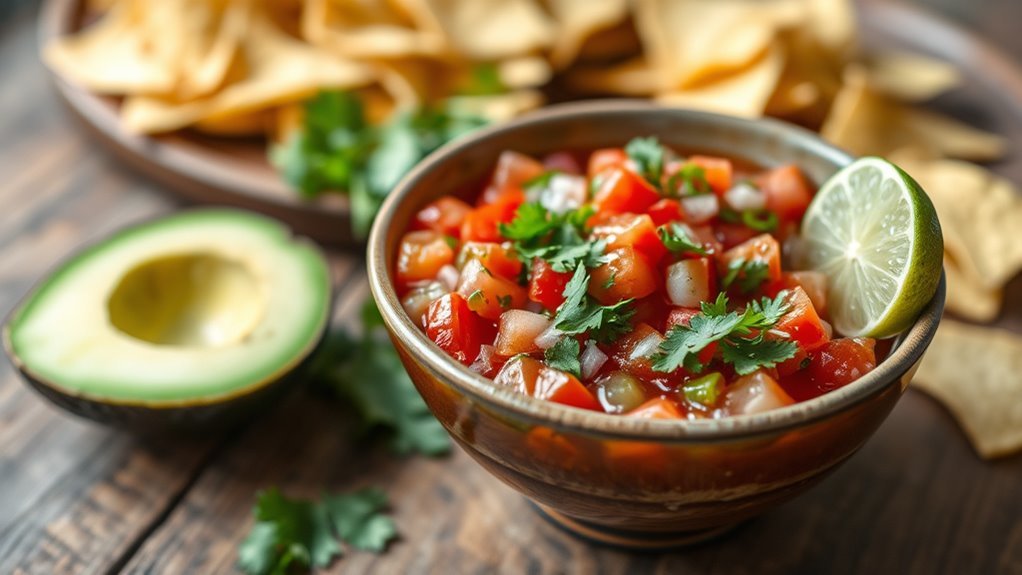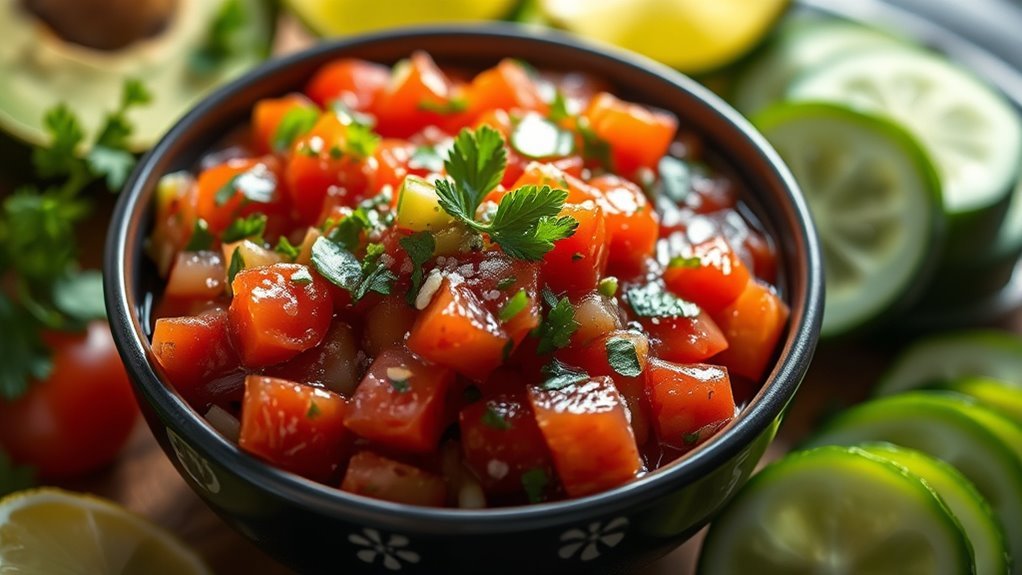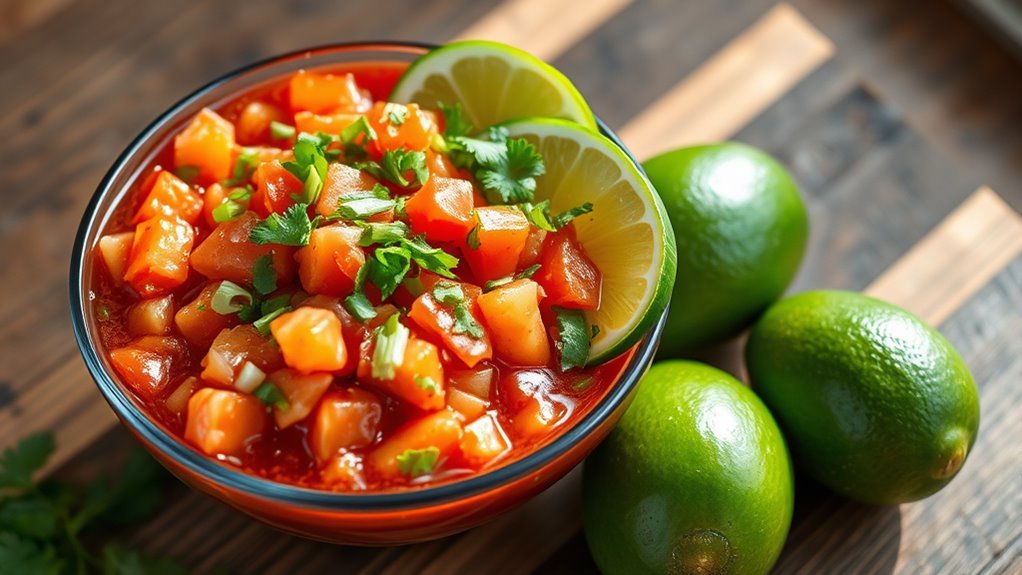Yes, you can have salsa on keto! Just make sure to choose low-carb ingredients like tomatoes, onions, and peppers. Fresh salsa generally has fewer carbs than canned options, but always check labels for added sugars. It’s a great way to add flavor while staying within your carb limits. Portion control is key, so be mindful of your serving sizes. Stick around for more tips on enjoying salsa while adhering to your keto lifestyle.
Understanding the Keto Diet

While many diets promise quick weight loss, the ketogenic (keto) diet stands out due to its unique approach to macronutrient consumption. At its core, the keto principles focus on drastically reducing carbohydrates and increasing fat intake, which shifts your body into a state of ketosis. This metabolic state enables your body to burn fat for energy rather than glucose. However, this shift comes with specific diet restrictions; you’ll need to limit high-carb foods like grains and sugars. Instead, you’ll be prioritizing healthy fats and moderate protein. Understanding these fundamental aspects of the keto diet is essential for anyone seeking a lifestyle that promotes freedom from traditional dieting constraints while aiming for effective weight management. The benefits of ketosis include increased energy and fat loss, making it a compelling choice for many.
The Basics of Salsa

Salsa, a vibrant and flavorful condiment, can elevate a wide range of dishes while fitting seamlessly into a keto lifestyle. It’s versatile, with countless salsa variations available, from classic tomato-based to fruity and spicy blends. When you make homemade recipes, you gain control over the ingredients, ensuring they align with your dietary goals. Fresh produce and herbs are often the stars, allowing you to create zesty flavors without added sugars or carbs. You can experiment with different bases, like avocados or tomatillos, to suit your taste. Incorporating low-carb leafy greens into your salsa can enhance both nutrition and flavor. Whether you’re topping grilled meats or mixing it into salads, salsa offers a revitalizing kick while keeping your meals exciting and satisfying on your keto journey. Enjoy the freedom to customize!
Common Ingredients in Salsa

Creating a delicious salsa involves a variety of common ingredients that contribute to its unique flavor profile. Tomatoes are the base for most salsa variations, offering sweetness and acidity. Onions add crunch and sharpness, while garlic enhances the overall depth of flavor. Fresh herbs like cilantro bring brightness, and lime juice introduces a zesty tang. Spices, such as cumin or chili powder, can elevate the taste further. If you’re looking for ingredient substitutions, consider using roasted peppers for a smoky twist or swapping out tomatoes for tomatillos in certain recipes. These adjustments allow you to explore diverse salsa variations while tailoring your dish to suit personal preferences and dietary needs, ensuring your salsa remains vibrant and satisfying. Additionally, incorporating low-carb ingredients can help keep your salsa keto-friendly while still being delicious.
Carb Counts of Salsa Ingredients
Understanding the carb counts of salsa ingredients is essential for those following a ketogenic diet, as it helps you make informed choices. Different salsa varieties can have varying carb levels, so knowing the counts of key ingredients is vital. Here’s a breakdown of common ingredients:
Understanding the carb counts in salsa ingredients is crucial for making informed choices on a ketogenic diet.
- Tomatoes: About 4 grams of net carbs per 100 grams.
- Onions: Roughly 9 grams of net carbs per 100 grams.
- Peppers: Around 6 grams of net carbs per 100 grams.
- Cilantro: Less than 1 gram of net carbs per 100 grams.
Consider ingredient substitutions, such as using lower-carb vegetables or herbs, to create a salsa that fits your keto lifestyle. This awareness empowers you to enjoy flavorful salsas without compromising your dietary goals. Additionally, onion varieties like green onions can provide a lower-carb option while still adding flavor.
Health Benefits of Salsa
Salsa is more than just a tasty condiment; it’s packed with nutrient-rich ingredients that can enhance your diet. As a low-calorie flavor booster, it adds zest to your meals without piling on the calories. Additionally, the tomatoes and peppers in salsa are known for their antioxidant properties, promoting overall health and wellness.
Nutrient-Rich Ingredients
While you might think of salsa as just a tasty dip, its nutrient-rich ingredients offer a variety of health benefits that can enhance your keto lifestyle. The combination of fresh vegetables and herbs creates ingredient synergy, promoting better nutrient absorption. Here are four key benefits:
- Rich in Vitamins: Tomatoes and peppers provide essential vitamins like C and A.
- High in Antioxidants: Ingredients like onions and garlic help combat oxidative stress.
- Low in Carbs: Salsa typically contains minimal carbohydrates, fitting perfectly into your keto plan.
- Hydration: The water content in tomatoes guarantees you stay hydrated, essential for overall health. Additionally, incorporating low-carb tomatoes into your salsa not only enhances flavor but also keeps your carb intake in check.
Incorporating salsa into your meals allows you to enjoy these benefits while sticking to your dietary goals.
Low-Calorie Flavor Booster
A low-calorie flavor booster like salsa can transform any meal without adding unwanted calories. With various salsa varieties available—from classic tomato-based to fruit-infused options—you can easily elevate your dishes. Each type offers unique flavor combinations that enhance your meals while keeping them light. For instance, a zesty mango salsa can add a sweet and spicy kick to grilled chicken, while a smoky chipotle salsa pairs perfectly with roasted vegetables. By incorporating salsa, you not only enhance taste but also increase your meal’s excitement without compromising your dietary goals. This makes salsa an ideal choice for those seeking flavorful freedom in their culinary adventures on a keto diet. Embrace the versatility of salsa and enjoy meals that satisfy your taste buds. Additionally, using salsa can help you maintain stable blood sugar levels while enjoying delicious flavors in your meals.
Antioxidant Properties
When considering the health benefits of salsa, its antioxidant properties stand out as a notable advantage. Salsa is rich in ingredients that provide numerous antioxidant benefits, enhancing salsa health overall. Here are four key reasons why these properties matter:
- Combat Oxidative Stress: Antioxidants help neutralize free radicals, reducing cellular damage.
- Boost Immune Function: They support your immune system, helping you fend off illnesses.
- Promote Heart Health: Antioxidants can improve cardiovascular health by lowering cholesterol and inflammation.
- Enhance Skin Health: They protect your skin from aging and UV damage, promoting a vibrant appearance.
Incorporating salsa into your diet not only adds flavor but also contributes greatly to your overall well-being. Enjoy the benefits while staying true to your health goals!
How to Make Keto-Friendly Salsa
When making keto-friendly salsa, your choice of low-carb ingredients is essential for staying within dietary guidelines. You’ll want to weigh the benefits of using fresh versus canned options, as each can affect flavor and texture differently. Additionally, consider various flavor enhancements to elevate your salsa without adding carbs, ensuring it remains delicious and compliant with your keto lifestyle.
Low-Carb Ingredients Selection
To create a keto-friendly salsa, it’s essential to focus on low-carb ingredients that maintain flavor without compromising your dietary goals. Here are some key components to reflect upon:
- Low Carb Vegetables: Opt for diced tomatoes, bell peppers, or jalapeños to add texture and taste without the carbs.
- Keto Friendly Spices: Use spices like cumin, coriander, and garlic powder to enhance flavor without sugar.
- Fresh Herbs: Add cilantro or parsley for an aromatic freshness that pairs well with your ingredients.
- Acidic Elements: Incorporate lime juice or apple cider vinegar for a zesty kick that balances the flavors. Additionally, consider incorporating the antioxidants in apricots as a unique addition to your salsa for an extra layer of flavor and health benefits.
Fresh vs. Canned Options
How does the choice between fresh and canned ingredients impact the final flavor and texture of your keto-friendly salsa? When you opt for fresh salsa, you’re likely to experience a vibrant taste and crisp texture that comes from using ripe tomatoes, herbs, and spices. Fresh ingredients can enhance the overall quality, offering a more robust flavor profile. On the other hand, canned salsa can provide convenience and a longer shelf life but may lack the brightness and freshness of its homemade counterpart. Additionally, you should check for added sugars in canned options, as they can compromise your keto goals. Ultimately, whether you choose fresh or canned, understanding these differences can help you create the perfect salsa tailored to your preferences. Moreover, incorporating keto-friendly ingredients into your salsa can further align it with your dietary goals.
Flavor Enhancements to Consider
While fresh ingredients lay the foundation for flavorful keto-friendly salsa, there are several enhancements you can incorporate to elevate the taste even further. Consider these enhancements:
- Spice Variations: Experiment with cumin, smoked paprika, or chili powder for depth.
- Herb Additions: Fresh cilantro, parsley, or basil can brighten the flavor profile.
- Citrus Zest: A hint of lime or lemon zest adds an invigorating zing.
- Garlic and Onion: Roasted garlic or finely diced onion can introduce a robust flavor. Additionally, using low-carb ingredients ensures your salsa remains compliant with keto guidelines.
Store-Bought Salsa Options
When you’re following a keto diet, finding suitable store-bought salsa options can be a challenge, as many brands contain hidden sugars and carbs. To navigate this, always check ingredient labels carefully. Look for store-bought brands that emphasize natural ingredients, like tomatoes, onions, peppers, and spices, without added sugars. Some brands specifically market their products as keto-friendly, which can save you time. Pay attention to the carb count per serving; ideally, you want options with less than 5 grams of net carbs. Be cautious of salsas labeled “sweet” or “fruit” as these often contain high-carb ingredients. By being diligent with your choices, you can enjoy salsa without derailing your keto journey. Additionally, considering the potential benefits of the keto diet, such as effective weight loss, can further motivate you to choose suitable salsa options.
Creative Ways to Use Salsa on Keto
You can elevate your keto meals by using salsa in unexpected ways. Consider it as a zesty salad dressing or a flavorful topping for your favorite keto snacks. Exploring these options not only enhances taste but also adds variety to your low-carb diet.
Salsa as a Salad Dressing
Salsa can transform a simple salad into a flavor-packed dish, making it an excellent choice for those on a keto diet. Using salsa as a salad dressing not only enhances taste but also keeps your carb count low. Here are some creative salad ideas where salsa shines:
- Taco Salad: Combine ground beef, cheese, avocado, and your favorite salsa for a hearty meal.
- Mediterranean Twist: Mix cucumbers, olives, and feta with salsa for a zesty Mediterranean salad.
- Avocado Salad: Toss sliced avocados and tomatoes with salsa for a revitalizing option.
- Grilled Chicken Salad: Top greens with grilled chicken and a generous drizzle of salsa dressing.
These options keep your meals exciting while staying true to your keto lifestyle.
Topping for Keto Snacks
Using salsa as a salad dressing opens up a world of flavor, and it can also serve as an exciting topping for various keto snacks. Consider pairing it with cheese crisps or avocado slices for a delightful crunch. You might also enjoy using salsa variations, like mango or pineapple salsa, which can add a surprising twist to your favorite keto-friendly dishes. For a heartier option, try topping grilled meats or roasted vegetables with salsa for added zest. Additionally, you can enhance your guacamole with a spoonful of salsa for an invigorating dip. These keto pairings not only elevate your snacks but also keep your meals vibrant and enjoyable while adhering to your dietary goals.
Portion Control and Serving Sizes
While enjoying salsa as part of a keto diet, it’s essential to contemplate portion control and serving sizes to maintain your carbohydrate limits. Being mindful of how much salsa you consume helps keep your overall macros in check. Here are some portion sizes and serving suggestions:
- Standard Serving: Aim for 2 tablespoons of salsa per serving.
- Vegetable Pairing: Pair with low-carb veggies like cucumber or bell peppers for a satisfying snack.
- Frequency: Limit salsa to a few times a week to avoid exceeding carbs.
- Homemade vs. Store-Bought: Consider making your own to control ingredients and serving sizes better.
Tips for Staying on Track With Keto
Staying on track with a keto diet can be challenging, especially with so many tempting high-carb options around. To maintain your commitment, consider meal prepping. Preparing your meals in advance not only saves time but also guarantees you have keto-friendly options ready when hunger strikes. For snack ideas, stock up on low-carb options like cheese, nuts, or veggies with guacamole. This will help you avoid reaching for unhealthy choices. Keep a food journal to track your carb intake and identify any patterns that may derail your progress. Finally, find a supportive community or accountability partner to share recipes and tips, making the journey more enjoyable and less isolating. You’ll feel empowered to stay on track with these strategies.
Frequently Asked Questions
Can I Use Fruit-Based Salsa on a Keto Diet?
You can use fruit-based salsa on a keto diet, but you’ll need to be cautious about your carb intake. Opt for low-carb fruit alternatives, like tomatoes or avocados, to keep it keto-friendly. When creating salsa recipes, consider incorporating herbs and spices to enhance flavor without adding carbs. Always check the nutritional content to guarantee you’re staying within your daily limits, allowing you to enjoy a tasty salsa while maintaining your keto goals.
Is Homemade Salsa Better Than Store-Bought for Keto?
Homemade salsa is like a garden of flavor compared to store-bought options. When you whip up your own, you control the homemade ingredients, ensuring they fit your keto goals. In a nutritional comparison, homemade salsa often boasts fewer additives and sugars than many commercial brands. So, if you’re craving freedom from hidden carbs and preservatives, making your own salsa is a deliciously empowering choice for your keto journey.
How Do I Store Leftover Salsa?
To store leftover salsa, transfer it into airtight salsa containers for ideal freshness. Make sure the containers are clean and dry before adding the salsa. You can keep it in the refrigerator for up to a week. For longer storage, consider freezing it in ice cube trays, then transferring the cubes to a freezer bag. This way, you can enjoy your salsa later without compromising its flavor or texture.
Can I Eat Salsa With Keto-Friendly Chips?
Absolutely, you can enjoy salsa with keto-friendly chips! Think of it as a dance of flavors where salsa varieties like pico de gallo or roasted tomato meet chip alternatives such as cheese crisps or sliced veggies. Just make sure the chips align with your carb goals. This combination can spice up your meals while giving you the freedom to indulge without straying from your keto lifestyle. Enjoy every bite guilt-free!
Does Salsa Have Any Hidden Sugars?
Yes, some salsas can contain hidden sugars, often from added ingredients like sweeteners or certain fruits. When you’re checking the sugar content, it’s essential to read the label closely. Many commercial salsas include preservatives or flavor enhancers that may contribute to the overall sugar levels. Opt for fresh or homemade salsa to avoid these hidden ingredients, ensuring you stay aligned with your dietary goals while enjoying the freedom of flavorful options.


